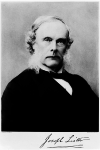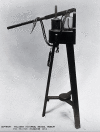Joseph Lister (1827-1912): A Pioneer of Antiseptic Surgery
- PMID: 36686094
- PMCID: PMC9854334
- DOI: 10.7759/cureus.32777
Joseph Lister (1827-1912): A Pioneer of Antiseptic Surgery
Abstract
Joseph Lister was a prominent British surgeon and medical scientist who established the study of antisepsis. Applying Louis Pasteur's germ theory of fermentation on wound putrefaction, he promoted the idea of sterilization in surgery using carbolic acid (phenol) as an antiseptic. His method reduced the incidence of wound sepsis and gangrene, which, in turn, reduced the need for amputation. By showing how germs could be prevented from entering the wound, Lister increased the safety of surgical operations and laid the foundations for all subsequent advances in the field.
Keywords: carbolic acid; louis pasteur; microorganisms; spontaneous generation; sterilization; wound healing.
Copyright © 2022, Michaleas et al.
Conflict of interest statement
The authors have declared that no competing interests exist.
Figures





Similar articles
-
Joseph Lister (1827-1912): a pioneer of antiseptic surgery remembered a century after his death.J Med Biogr. 2012 Aug;20(3):107-10. doi: 10.1258/jmb.2011.011074. J Med Biogr. 2012. PMID: 22892302
-
Joseph Lister's surgical revolution.J Invest Surg. 2010 Oct;23(5):241-3. doi: 10.3109/08941939.2010.520574. J Invest Surg. 2010. PMID: 20874477
-
Louis Pasteur: Between Myth and Reality.Biomolecules. 2022 Apr 18;12(4):596. doi: 10.3390/biom12040596. Biomolecules. 2022. PMID: 35454184 Free PMC article. Review.
-
[The birth of modern surgery].Sven Med Tidskr. 2007;11(1):89-93. Sven Med Tidskr. 2007. PMID: 18548947 Swedish.
-
Louis Pasteur (1822-1895), Ignaz Semmelweis (1818-1865), Joseph Lister (1827-1912) and the Link Between Their Works Toward the Development of Antisepsis: A Narrative Review.Cureus. 2024 Jun 17;16(6):e62543. doi: 10.7759/cureus.62543. eCollection 2024 Jun. Cureus. 2024. PMID: 39022474 Free PMC article. Review.
Cited by
-
Palliative surgery: state of the science and future directions.Br J Surg. 2024 Mar 2;111(3):znae068. doi: 10.1093/bjs/znae068. Br J Surg. 2024. PMID: 38502548 Free PMC article.
-
Comprehensive Assessment of Health Risks Associated with Gram-Negative Bacterial Contamination on Healthcare Personnel Gowns in Clinical Settings.Microorganisms. 2025 Jul 18;13(7):1687. doi: 10.3390/microorganisms13071687. Microorganisms. 2025. PMID: 40732197 Free PMC article.
-
The Mayo Brothers: Pioneers of Modern Medicine and Patient-Centered Care.Cureus. 2024 Oct 11;16(10):e71269. doi: 10.7759/cureus.71269. eCollection 2024 Oct. Cureus. 2024. PMID: 39525208 Free PMC article. Review.
-
Louis Pasteur: A Legacy Unmasked.Cureus. 2024 Aug 29;16(8):e68080. doi: 10.7759/cureus.68080. eCollection 2024 Aug. Cureus. 2024. PMID: 39347279 Free PMC article. Review.
References
-
- Simmons J. Boston: Houghton Mifflin. Boston: Houghton Mifflin; 2002. Doctors and Discoveries: Lives That Created Today's Medicine. From Hippocrates to the Present.
-
- Rickman J. London: Macmillan and Co. 1918. London: Macmillan and Co.; 1918. Lord Lister.
Publication types
LinkOut - more resources
Full Text Sources
